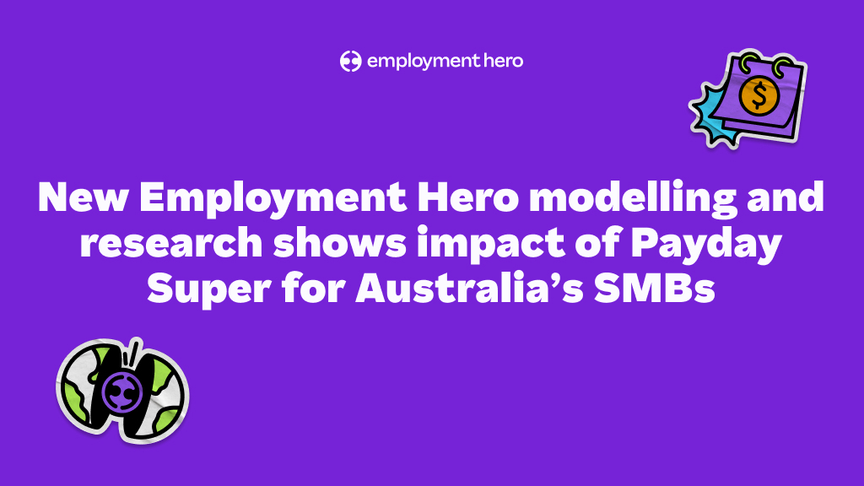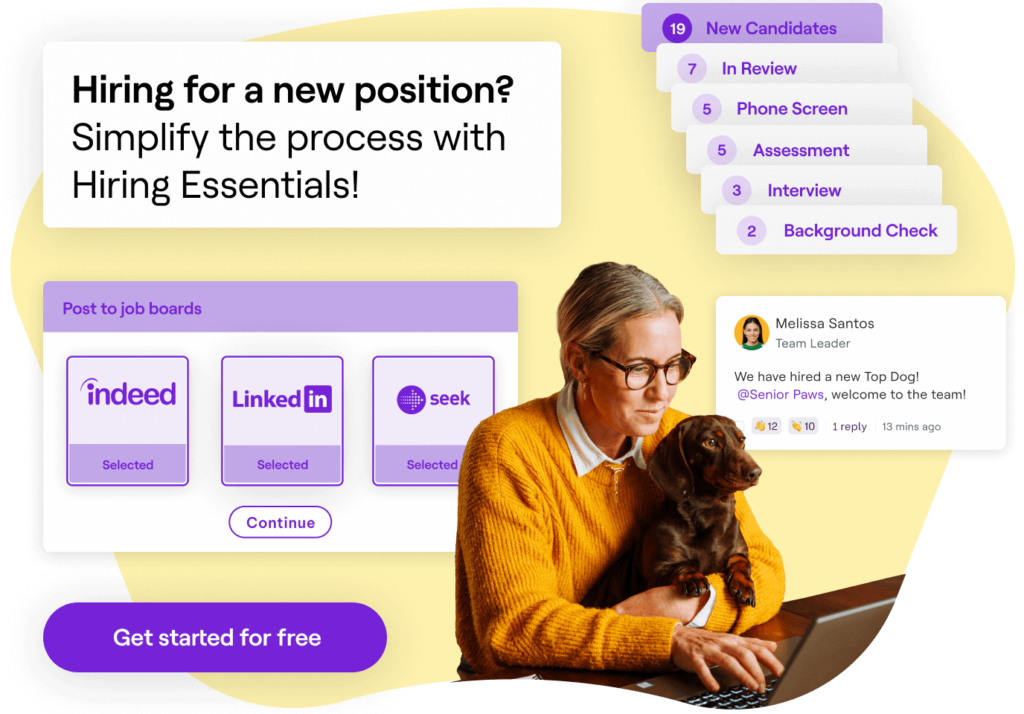What is an Employment Contract? [Australia Guide]
Employment contracts help define an employment relationship and allow both the employer and employee to get on the same page.

Congratulations! If you’re reading this blog you must be on the verge of hiring your first staff member and writing your own employment contract. Building a team is an exciting step in growing your business so here’s to you!
On the flip side, it can also be a little scary. For instance, there are all the legalities to consider.
Employment shouldn’t be stressful! We want to help you navigate the complexities of hiring. Let’s start with the first formal document you’ll need to draw up; the employment contract.
What are employment contracts?
An employment contract is a legally binding document between employer and employee that lays out the agreed terms and conditions and employment agreements that each party will abide by for the duration of the employment term.
It’s designed to protect you (the employer) and your new employee, ensuring there is no confusion on requirements or remuneration for the job that needs to be completed.

Is a written contract required?
You might be surprised to learn that written employment contracts are not legally required in Australia. A verbal or “handshake” agreement is fine, and plenty of small businesses successfully employ staff in this way.
However, if you’re taking this (albeit handy) shortcut, proceed with caution.
Remember, employment contracts are there to protect you and your staff. If the terms of your agreement aren’t set out in black and white, how will you prove those terms should something go wrong?
Verbal agreements, compared to written employment contracts, are easily misconstrued and/or disputed, and unfortunately, you will experience difficulties in managing staff without a clear set of guidelines.
You should also be aware that legislation such as the Fair Work Act is geared towards protecting employees more so than employers.
As such, you may find that a written contract is worth the extra work up front to minimise risk later on. Not sure what role Fair Work plays in employment contracts? We’ve written this helpful article explaining who the Fair Work Ombudsman is here.
Keep in mind that all employees are covered by the National Employment Standard (NES), no matter what kind of agreement they have in place, be it written or verbal.
This means that no matter what, you must ensure all employees are afforded their basic employment rights, and minimum entitlements, like wages, are met. Read on below for more on the NES.

How should employment contracts be written?
Employment contracts written in plain English help you minimise costly and time-consuming disputes or legal issues by providing certainty about the legal rights and obligations of both you and your staff.
Although you might work with an employment lawyer to help you write an employment contract, the contract itself should ultimately be easy to read and understand.
If you’re unsure about what to include to ensure compliance, check out our essential guide to HR compliance in Australia here.
When are employment contracts generally issued?
Employment contracts are generally issued when you send the offer letter or email to a successful candidate.
The offer letter should congratulate the successful candidate, and outline the basic details of their employment. The letter or email should have their employment contract attached, ready to be signed and returned to secure their employment.
Not sure how to phrase your offer letter or email? Our free offer letter template can help.
Note: Have you heard the term “at will employment” floating around? Maybe you’re wondering if you need to write up “at will employment contracts”? This is a term and concept used in the United States, and is not used in Australia.

What type of employment contract do I need?
Just like your employees, every employment contract is unique; a standard employment contract simply doesn’t exist.
This probably isn’t what you want to hear as a busy business owner (sorry!) but tailoring your contract of employment to each new hire is best practice. It’s all about ensuring terms are clear and understood, and risk is minimised for both parties in the employment relationship.
The good news is, there are three key questions you can ask to help narrow down the type of employment contract you need. Keep in mind that employees may want to discuss or adapt the terms of the contract first.
If you need help, we’ve written this handy workplace policy guide to help you navigate the differences between employment contracts, HR documents and workplace policies.
1. Is the role covered by an award or enterprise agreement?
Awards are legal documents that detail the necessary conditions for each type of employment.
In Australia, there are over 100 industry or occupation awards, so it’s likely the role will be covered by one.
It’s important to know which award is relevant because it will set out minimum pay rates and conditions. Work out which award applies to your situation here.
2. Is the role full-time, part-time or casual?
Clarity around this question is key to ensuring you meet the minimum requirements set out by the NES.
For example, full-time staff expect ongoing employment, regular hours and paid time off.
Part-time staff, casual staff, and independent contractors rarely enjoy these perks but will take home a higher hourly pay rate.
3. Is the role permanent or temporary?
The primary differences between these options are the flexibility it allows, and how an employee can be terminated.
For example, if your new hire is permanent, they’ll need to give you adequate notice should they wish to resign from their position.
An independent contractor or employees under casual employment could resign with a shorter notice period.
Bringing on board an independent contractor will require a slightly different employment contract to bringing on a standard employee. Their onboarding experience will likely be different too, considering they will only be working with your business for a limited time.
Learn more about the differences between hiring a contractor and employee.

What to include in an employment contract
It might sound obvious, but start with the basics and work from there. Your employment contract should include:
- The full name and contact details of both yourself (the employer) and your new employee
- Job title
- Details of your business location and a commencement date
- A detailed explanation of the role. Ensuring that you break down all duties, responsibilities and obligations so your new hire understands exactly what is expected of them
- Who your new employee will report to, and what decisions (particularly financial decisions) can they make autonomously
- Any minimum period of employment, probationary period, or trial period requirements
- Set out agreed remuneration and notice of termination requirements
From here, an employment contract must set out and provide the basic ten minimum entitlements outlined in the NES. These are;
- Maximum hours per week
- Flexible working arrangements
- Parental leave and related entitlements
- Annual leave entitlements
- Personal or carer’s leave entitlements, including compassionate and unpaid family leave
- Community service leave entitlements
- Long service leave entitlements
- Public holidays
- Details of termination and redundancy pay
- A copy of the Fair Work Information Sheet
Finally, consider including any specific conditions or clauses to protect and/or benefit you as the employer. These might look like this:
- A confidentiality clause to protect trade secrets, intellectual property and confidential information
- A non-compete clause to prevent your employee from leaving to work for a competitor
- A non-solicitation clause to ensure you maintain full ownership of client relationships
- A trial or probationary period to ensure the employee is the right fit for your business
- A code of conduct and/or dress code that you’d like to see your employee follow

Every employment relationship is different
A written employment contract is a legally binding document that lays everything out on the table; terms, expectations on employee’s performance, contingency plans and more.
It’s designed to protect your employee but also you and your business, so it’s worth putting in the time to get it right. It’s a key part of building a trusting and transparent employment relationship.
Unfortunately, there is no one template that you can copy and paste because every employment contract will be different. Reference the essential inclusions and then build your contract out from there.
Make use of resources like Fair Work to understand the inclusions set out by the National Employment Standard, differences between contract types and ideas on clauses that may be relevant to you.
Also, don’t hesitate to consult an employment lawyer if you’re not sure how to put together your employment contract. Getting some advice for your specific situation can help you create the most accurate document, and give you a great knowledge base for the future.
If you’re currently seeking an employment lawyer in Australia, our friends at Employment Innovations may be able to help.
If you’re considering hiring overseas, here is the breakdown of the hiring costs in:

The benefits of using digital contracts
Everything’s going digital these days, and employment contracts are following suit!
But what are the benefits of using an electronic employment contract over a classic paper version? Well, they simply make life a whole lot easier for you and your employees. Here’s how.
1. They save everyone time
With traditional paper contracts, you have to create the document, print it, and send it out via snail mail. Alternatively, you might send a copy via email – which will require your new hire to print it out and send it back to you (and who has a home printer these days?).
With digital contracts, you’ll simply flick it over to your new employee via the cloud. They can receive it, make a digital signature and have it back to you within minutes.
2. They streamline the offer process
Every hiring manager will know that recruitment is a race! The faster that you secure that person, the more you reduce the risk of having them be snapped up by another company.
When you’re working digitally, you streamline the whole offer process. It’s not only faster, but it’s also simpler. It can help you get your new recruit confirmed and excited to get started.
Looking for a way to simplify your hiring process? Go digital and save time with our ATS software.
3. They are easily accessible
Are you heading into a performance review and need to quickly review details of someone’s employment? Maybe your employee wants to double-check their work details at tax time?
These are tasks that, before electronic contracts, could have held you up for an hour (or more!). Instead, you can access your digital files securely and in seconds on the cloud.
Using electronic employment contracts can help you ditch tedious filing tasks. Search for an employee’s contract in seconds and say bye-bye to filing cabinets for good.
4. They reflect well on your business and HR team
Digital contracts are just one of the recruitment tools that your HR teams can use to provide a great recruitment experience.
Instantly receiving a digital contract after they accept an offer can help build a new team member’s confidence in your business. It shows that your business and HR team are efficient, tech-savvy and helpful.
See four more reasons why you should make the switch to digital employment contracts.
Wondering if electronic signatures are legally binding in Australia? Clear up any confusion and learn the ins and outs of e-signing contracts here.

Other essential parts of the onboarding process
When you issue your employment contract, it’s also best practice to include some other essential onboarding information.
Workplace policies
Every business needs to have clear and easy to understand workplace policies and procedures in place.
They protect your business from a range of situations, whether it’s social media, inappropriate computer use, discrimination or harassment. Policies are key to developing your business through your people and protecting it against financial risks.
A policy is only effective if properly communicated and uniformly enforced to all employees. This means you need to explain the policy and provide training if necessary to ensure your employees understand how to comply with the policy and the consequences if they breach it.
Make sure employees sign off on a document acknowledging that they are aware of the policy and understand it completely.
Common policies
Some common policies for Australian small businesses include;
- A code of conduct
- Recruitment policy
- Internet and email policy
- Drug and alcohol policy
- Health and safety policy
- Anti-discrimination and harassment policy
- Grievance handling policy
- Discipline and termination policy
- Social media policy
Did you know that Employment Hero has a library of HR policy templates written by employment experts on our platform? Learn more about how our HR tools can help you streamline hiring.

Employee handbook
If you have one, distribute your employee handbook to your new team member early in the onboarding process.
An employee handbook will likely not cover the formal information that has been covered in the employment contract. Rather, think of it as a friendly introduction to your business.
Common elements of an employee handbook
What your employee handbook includes is up to you, but here are some helpful additions that will help your team member get started;
- A brief history of the business
- Information about your company’s mission and values
- An overview of your business goals
- An introduction to the senior leaders of the team
- An organisational chart to better understand who’s who
- Any details on your company culture (when does the team come together, what do they do to celebrate their achievements)
- A training manual (if required)
Job description or list of duties
A job description or position description (JD or PD) should be a comprehensive document that gives your employee a deeper understanding of their role.
While a job description or list of duties is generally provided at the recruitment stage, it’s always a good idea to reissue these on commencement of employment. Providing this kind of document can help your new employee prepare for their role, and can give them a reference to return to throughout their employment.
Creating your best job description
Not sure how to create a comprehensive job description? Our free job description template can help.

Employment Hero can help!
Did you know that Employment Hero has an easy Paperless Onboarding feature? This feature can support you in quickly putting together a fully compliant digital employment contract that can be signed electronically.
If having a new hire fully onboarded in a couple of minutes prior to their start date sounds like a dream to you, get in touch with one of our small business specialists today.
Disclaimer: The information in this article is current as at 28 May 2022, and has been prepared by Employment Hero Pty Ltd (ABN 11 160 047 709) and its related bodies corporate (Employment Hero). The views expressed in this article are general information only, are provided in good faith to assist employers and their employees, and should not be relied on as professional advice. The Information is based on data supplied by third parties. While such data is believed to be accurate, it has not been independently verified and no warranties are given that it is complete, accurate, up to date or fit for the purpose for which it is required. Employment Hero does not accept responsibility for any inaccuracy in such data and is not liable for any loss or damages arising either directly or indirectly as a result of reliance on, use of or inability to use any information provided in this article.You should undertake your own research and to seek professional advice before making any decisions or relying on the information in this article.
Related Resources
-
 Read more: Guide to long service leave entitlements in Australia
Read more: Guide to long service leave entitlements in AustraliaGuide to long service leave entitlements in Australia
Understanding long service leave entitlements can be challenging. We share everything employers need to know about managing it.
-
 Read more: The $124,000 Cashflow Crunch: Small and Medium Businesses (SMBs) at risk under proposed Payday Super Requirements
Read more: The $124,000 Cashflow Crunch: Small and Medium Businesses (SMBs) at risk under proposed Payday Super RequirementsThe $124,000 Cashflow Crunch: Small and Medium Businesses (SMBs) at risk under proposed Payday Super Requirements
New Employment Hero modelling and research shows businesses will need an extra $124,000 in working capital on average to meet…
-
 Read more: From hiring mismatch to SmartMatch: 5 critical things your recruitment strategy is missing
Read more: From hiring mismatch to SmartMatch: 5 critical things your recruitment strategy is missingFrom hiring mismatch to SmartMatch: 5 critical things your recruitment strategy is missing
We’ve wrapped up five critical things your recruitment strategy might be missing so you can feel confident in your hiring…






















